Text
Patch 1.11.1
I have misremembered how Hypno's attack works - after the changes to the Sleep condition its attack no longer made sense. As such, I have gave it a new, more exciting attack that's both a damage dealer and an enabler.

Fun fact - while Hypno's second attack was directly translated as "Dark Mind", it's actually the name of another official attack - "Night Shade"! It's an attack that Hypno couldn't ever learn all the way up to generation 9. I wrested with changing the name, but decided it's a somewhat funny easter egg.
1 note
·
View note
Text
Patch 1.11
First of all, thank you for all your continued support!
Excuse this incidental blog post, but I want to address the state of the project at this moment. You might have noticed a lack of updates in the recent times. On one hand, I have always intended for this project to "end" at some point but, on the other, I was actually sitting on some changes I wanted to bring into the format. The reality of the situation is that, in recent months, I have switched jobs a few times, making it quite a chaotic time. It's all good now - I have found a studio making a kick-ass game that I am sure will compete with the best in the business. I am also working on my own RPG project on the side. All of this is to say, Base Set Remastered has taken a back seat during this time. That is, until now.
If you've visited the Set List recently, you might have noticed that all the pictures are missing. This is because Discord has stopped allowing hosting images outside of their platform. This has forced me to re-upload all cards to a different host website and, given that it's quite a bit of work to fix the Set List, I have procrastinated of this task. This is because I also wanted to make a Patch at the same time. But enough self-deprecation - if you're reading this, I have done it, all the pictures are back on the site and these are the new patch notes.
Putting "Special" back in "Special Conditions"
One of the first changes I've implemented in this format, before the cards were even finalized, was to make a blanket rule - or more specifically, remove a rule from the original game - that all Effects on a Pokemon stay on it, even if it was retreated. That, to me, was sensible at the time - for starters, just from experience I knew that this rule was confusing to new players. If an Effect says a Pokemon cannot do something "this turn", it stands to reason this change sticks around for "this turn" and not just for as long as the Pokemon is Active. Additionally, I wanted to remove cases where double-Switching a Pokemon would just remove all effects and make it brand new.
In reality, the latter case would never happen, as I made it impossible to double-Switch a Pokemon during a single turn - on purpose. As such, this rule doesn't really apply anymore. Additionally, it's somewhat inconsistent with the video games - in the games, it's the Special Conditions that stick around, while all effects, good or bad, wane from a Pokemon once it's switched. As such, the rule is changed - all Effects are cleansed from a Pokemon when it is switched UNLESS it's a Special Condition (that's not Confusion, of course).
Now that we're on the topic of Special Conditions, there are a few changes in that category as well.
Resident Sleeper
After many games of testing, I really felt like Sleep is in a weird place. In many ways it's just a "better Paralyze", that needs flips to go away. That said, it doesn't feel satisfying even for the attacking side, as Sleeping Pokemon tend to get immediately Benched until they wake up, which they usually do quite fast. Any attacks such as Nightmare have a low chance of succeeding, as nobody would stick a Sleeping Pokemon in the Active Spot. There had to be a better way.
We had a few great discussions on our Discord (thank you!). Ultimately my thoughts wandered back to the video game for the inspiration. The video game sleep has one major difference from the TCG Sleep - the owner of the Sleeping Pokemon chooses an attack, then a check is performed if the attack went through. If it did - great, the attack goes through! If not, the Pokemon continues sleeping. Now, this was NOT the case in Generation 1, but since the theme of the format is to bring "modern design to the old game", that's a piece of official balancing that I'm happy to bring back.
So, what's the rule exactly? Sleep is now a permanent effect - it doesn't go away on its own, and stays on the bench. The only way to get rid of it is to announce an attack (or pass the turn) when your Active Pokemon is asleep. After you do, you flip - just like you would during a Confusion. If you flip tails, the Pokemon stays asleep, and the attack does nothing. If you flip heads, the attack goes through and Sleep ends permanently.
What does it mean? This Special Condition is now completely different and plays differently. For starters, it objectively has 50% chance of doing nothing. Your opponent might flip heads on the attack and render the effect useless. However, unlike in the official game, where you get that information immediately at the start of your turn, here you get it after you announce an attack. This completely flips the planning on its head - are you going to risk your attack to wake up your Pokemon, or are you going to retreat into a fresh attacker? If you do, the Sleep sticks around to annoy you another day.
I believe the old Sleep and new Sleep have roughly equivalent power levels, meaning I won't change the costs of any attack that afflicts it. I am excited to see how this change will affect gameplay.
Toxic
In design you often spot mistakes that need to be fixes. Sometimes you can manage to do it on your own and, the better you are, the more likely it is you'll do so. Often, however, these mistakes will be pointed out by your coworkers. And when you work by yourself on a project, like I do here, it is very likely that some mistakes will be spotted by the players themselves. So was the case with Poison.
In my hubris I thought I came up with a cool way to manage Poison - each Poison Counter would deal 10 damage to a Pokemon. If a Pokemon would "become Poisoned", that would mean placing a Poison counter on them, if they don't have one yet. Certain cards, most notably Nidoking, expanded on that idea and allowed the player to place more Poison counters on a Pokemon. This is where trouble started brewing. Look at this Nidoking card below.
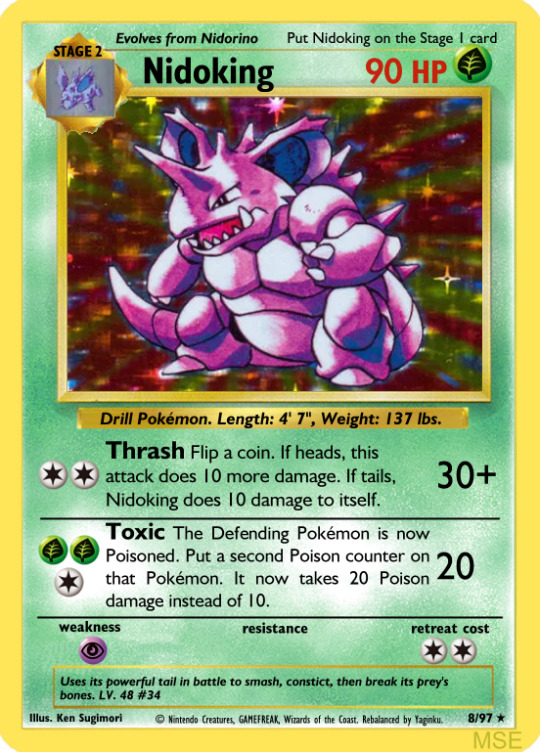
What does a "second Poison counter" mean on this card? It's easy enough to understand when that Pokemon is not Poisoned, but what if it already is Poisoned? Also, why does the last sentence specify the effect of the Poison counters? If that Pokemon had, say, four Poison counters on it, would the last sentence change how the damage behaves? It is just an extremely confusing wording for this effect.
Now, take into account Ekans as well:
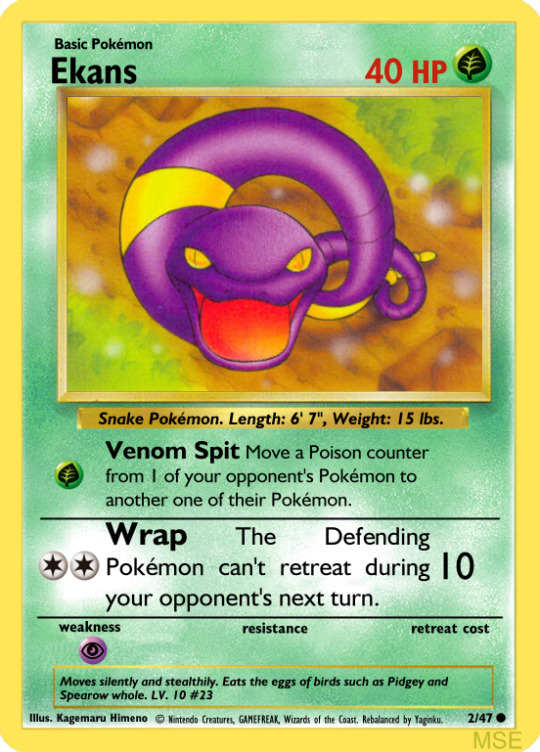
Ekans allows you to move a Poison counter. This is less confusing after I explained the Poison mechanic, but the point stands - such advanced effect shouldn't exist on a Basic Pokemon, allowing you to stack Poison counters for massive damage.
As such, here is the full explanation of the Poison mechanic:
A Pokemon is "Poisoned" when it has at least 1 Poison Counter on itself. Each Poison Counter denotes 1 damage counter the Pokemon takes at the end of its owner's turn, if that Pokemon is in the Active Spot.
When a Pokemon is "now Poisoned", a single Poison Counter is placed on it unless that Pokemon is already Poisoned, in which case nothing happens.
When a Pokemon is "no longer Poisoned", all Poison Counters are removed from that Pokemon.
Effects might place or move Poison Counters.
As for the changes, Nidoking receives a new wording. Ekans, on the other hand, receives a pretty standard "apply Poison" attack - I always felt like the "Jessie & James" deck was lacking a good, early-game Poison applier.
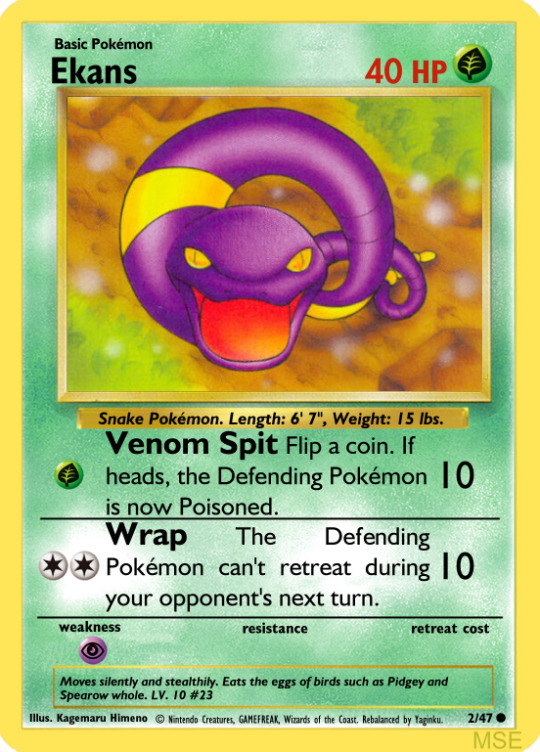
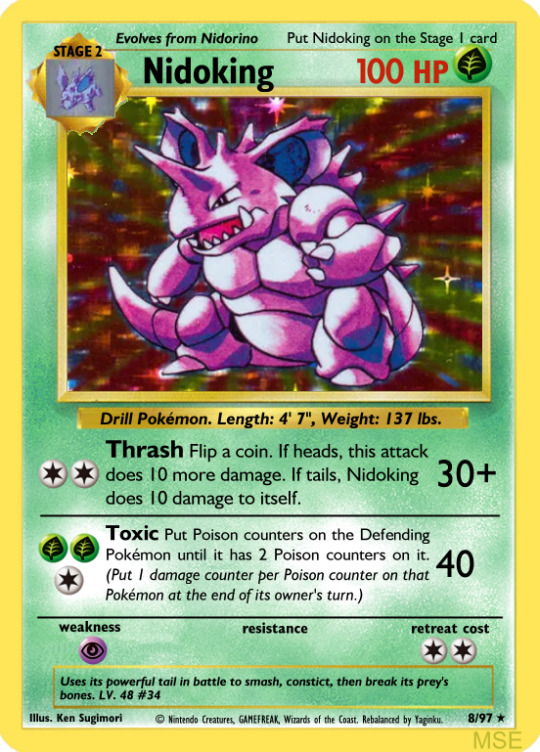
Stand Up Applause
Finally, a small change that's all about fanservice. I have learned that, apparently, many people consider Wigglytuff's "Do the Wave" attack to be iconic. I have moved this attack to Gyarados to better suit the Water type but, in all fairness, it's also true that Normal-type has access to all effects. As such, I have gave back this attack to Wigglytuff and replaced the frankly overdesigned alternative.
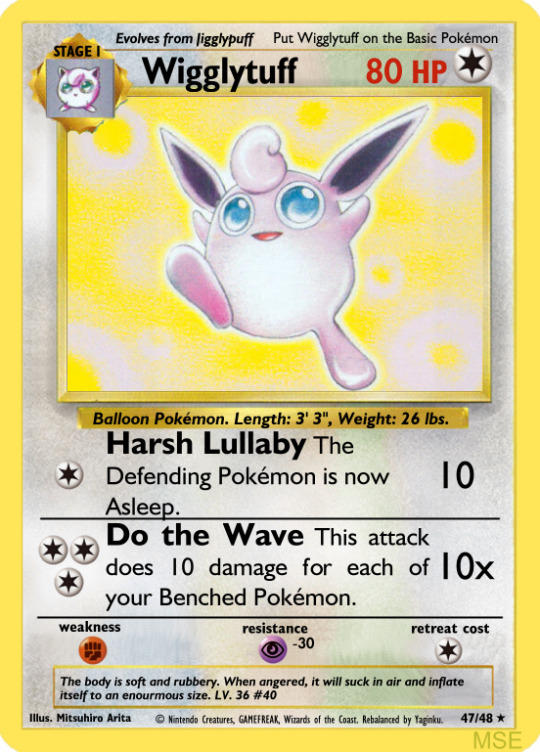
0 notes
Text
Building your first Base Set Remastered deck - tips & tricks
If you're a new player to Base Set Remastered - or maybe even a new player to Pokemon TCG in general - building your first deck can be a daunting task. So, what should you do to make that first deck of yours?
Pick your favorite Pokemon
While this point is at the core of every deck, it's also the one that's the most fun - do not worry about making your deck extremely optimal and focus on cards that look like fun! Or, perhaps, include all of your favorite Pokemon. Base Set Remastered is designed in such a way to make the game fun regardless of your build.
That said, if you want to step-up your deck, make sure to include some strong non-evolving Pokemon for a smooth early-game; some good Stage 1 Pokemon for the middle-game; and of course some massive Stage 2 beatsticks to finish the game. And don't forget about mixing different Types to cover your weaknesses!
2. Pick your draw Supporters
Playing Pokemon TCG ain't no fun if you don't have any cards in your hand! Include at least 10-12 Support cards that draw you cards, such as Bill or Professor Oak! Fine tune your hand with cards like Pokedex and Maintenance, to make sure you're not stuck with cards you don't need at the moment.
3. Pick your Energies
Now that you have your Pokemon and a way to draw them, put enough Energy in your deck to power them. 10-14 Energies is a good number, depending on how expensive the attacks in your deck are.
4. Finish up your Deck
If you have any space left, pick some Item cards that are going to help your deck. There's plenty of choices from Pokeballs, Potions and Pokeflutes. Experiment with what your deck needs most!
5. Shuffle up and Play!
Congratulations, your deck is completed! All that's left is either visiting our Discord OR printing the cards so you can play with your friends and enjoy the nostalgia of Base Set without any broken cards!
1 note
·
View note
Text
The Secret Most Broken Card in Pokemon TCG
This is going to be a whole essay about one particular card. Said card might be one of the most underrated cards in the game - even though everyone uses it, and widely appreciates its effects. It’s Switch.
As I’ve said in a different post, I don’t like that Switch can essentially negate Retreat Costs. Decks that use Pokemon with high retreat costs are generally forced to circumvent the whole mechanic, usually by using Switch and other switch-like-effects. If your Pokemon’s Retreat Cost is 3 or 4, you’re never paying that cost, unless in the most dire of circumstances, or to win the game immediately with a different attacker.
Because of that, I had suggested rewording Switch to something like “Remove from your active Pokemon an amount of energies equal to its Retreat Cost minus two, then switch”. Ignoring how wordy this textbox is on a card that had one simple sentence before the change, there’s one more word in it that I’m not sure is really necessary - the “switch” itself.
“Switch” describes a retreat that doesn’t use your retreat for a turn (in fact, retreating is a form of switching, not the other way around). It’s necessary for effects such as “after this attack, this Pokemon switches with 1 of your benched Pokemon”, or “switch your opponent’s active Pokemon with 1 of their benched Pokemon”. But it’s not clear to me it’s actually advantageous to include it on Trainer cards and allow players to double-switch during a turn.
This aspect of Switch doesn’t play a massive role in Base Set-Fossil, but in general it allows for some Pokemon to become “pivots” - utilize specific Abilities that only work in the Active Spot, then retreat for your main attacker to avoid taking damage. It also allows you to clear the Active Pokemon from all negative effects, then immediately attack again. While not every deck utilizes pivots, they do seem to pop up a lot - so a discussion about Switch is really a discussion about pivots and their place in the game.
Are cards like TEU Jirachi good design? I don’t really believe so. Firstly, they’re really finicky - you’re not going to print a card like TEU Jirachi every set, meaning you will usually end up with one card in the format for every deck that needs this kind of effect. Secondly, there’s really no reason for these effects to not be on attacks - they speed up early game to such a degree, that having a bad starting hand becomes even more punishing. Finally, I’m already not very hot on Ability-Pokemon that hog space on the bench simply to increase consistency.
So, let’s be mindful about the design space being closed or altered by having Switch - one is cards like TEU Jirachi, but it’s not clear if we want to see this archetype at all. Avoiding this collision is as simple as not printing that type of Pokemon in general, given they really don’t have much use outside of abusing Switch. Another affected area are attacks such as “if this Pokemon became your Active Pokemon this turn”, which become much weaker when they cannot abuse Switch to trigger this effect each turn. Again, that’s not a bad thing - we get more control over the strength of these effects, and they get to keep their main use case. And finally, you don’t get to “cleanse” your Pokemon from conditions and effects by using Switch + Retreat - which actually opens the design space for many more exciting cards that interact with special effects.
What’s the conclusion then? Well, ultimately, it’s a what-if scenario anyway and, in my opinion, Switch is one of these cards from Base Set that is on a ridiculously high power level for a Trainer, but somehow slipped through the cracks, unchanged. But, should it be rewritten, or scrapped completely? Giving examples on how Switch can be abused wasn’t that hard, but it’s a much harder task to analyze whether “lower retreat cost by 2” isn’t great either.
Switch belongs to a range of cards that let you convert deckbuilding resources and, later, card advantage into an effect. At their best, cards in this range should help you in doing something you’re already doing, not be an alternative. Potion is a classic example of the former - it doesn’t “circumvent” health, it doesn’t make it meaningless (like Max Potion or Scoop Up do), it helps you achieve something you already want to achieve (keep your Pokemon alive) and adds flavor on top of the basic mechanic. A deckbuilding case would be - “My Pokemon generally benefit from staying alive, so healing is a good inclusion”. Healing is generally better on Pokemon with high health or, better yet, ability to prevent damage, so it’s a natural combo.
Switch, on the other hand, is an alternative to retreating, and that’s not fixed even by changing it to “lowering retreat cost”. Paying the retreat cost is not the goal of retreating, it’s to bring a different Pokemon to the Active Spot. Switch doesn’t really make that part better, it just makes it “less worse” - you’re not including the card to bolster a strength, but to remove a weakness. If you need to circumvent the Retreat Cost mechanic, then the entire mechanic has failed to be fun and/or balanced.
...and that's another question worth answering. What is the purpose of Retreat Cost? Is it to punish you for not having Switch in your hand? I don't think so, even though it usually ends up working this way. In an ideal scenario, Retreat Cost makes you commit to a big attacker, and increases the depth of your forward-planning. But if that's the case, then it does a really bad job. Squirtle is not a "big attacker", yet the game still expects you to lose a turn worth of energy to front someone different. This ends up creating bad openings, where having an optimal 1st Turn Pokemon isn't just better, but having a bad one becomes disastrous - sometimes resulting in having to sacrifice them, while the actual frontliner waits on the bench for their turn. Nobody needs to be punished for wanting to retreat their Squirtle, and it would make the opening hands so much less volatile.
Conclusion
Base Set Remastered massively reduces Retreat Costs across the board, dropping them to values that players are actually willing to pay, and that reflects their importance on the board. Switch becomes “Retreat Aid” - players can no longer access switch effects during their turn, meaning there’s only one retreat per turn. Retreat Costs are roughly separated into card classes, though obviously they can be used as upsides or downsides while balancing cards.
No Retreat Cost: These are reserved for Pokemon that are weak and deal relatively little damage, usually waiting to be evolved - such as Squirtle/Charmander/Bulbasaur.
1 Retreat Cost: These appear on Pokemon that are mainline attackers, but don’t have the most extremely damaging attacks, such as Hitmonchan or Lapras.
2 Retreat Cost: These appear on the most powerful of Pokemon, with the most powerful attacks, such as Blastoise or Charizard.
I am aware that multiple Retreat Aids can be used to reduce the Retreat Cost to 0, but I’m absolutely fine with that - it’s a lot of card advantage to give up for that effect.
Now, it might seem that we haven’t really addressed the issues I’ve mentioned before, we have simply just moved a couple of numbers around and the mechanic hasn’t changed much - however, the scale of the effect is important. This is the difference between Potion and Max Potion - one is tame and completely balanced, while the other is widely out of scale and easily exploited. By moving Retreat Costs into an area where they’re easier to pay, we’ve made it a mechanic that doesn’t have to be circumvented, therefore it is okay to present a card that - as I’ve said above - helps you achieve something you already want to achieve, rather than skipping the mechanic altogether.
1 note
·
View note
Text
Reminder! This Sunday we are playing Base Set Remastered on Tabletop Simulator!
Join our Discord to learn more:
0 notes
Text
Pokemon TCG Base Set 25th Anniversary!
Today marks the 25th birthday of Base Set - at least if you count the western releases. To celebrate the occasion, it's time for a massive update to Base Set Remastered!
First: Black Star Promos join the fray! 14 new cards are now available and, as always, you can check them out in the Set Display.
Second: We now have playdates! Join our Discord and read up on when's the next occasion to sling some Base Set on Tabletop Simulator!
Third: Patch 1.10 has just been released! If you've played before, check out the changes, as they are quite massive! You can find the post here.
Thank you for your support! This project celebrated its third anniversary last month. It's an amazing ride and it is only now picking up heat!
2 notes
·
View notes
Text
Patch 1.10
tl;dr
Poke Ball rework.
Pokedex rework.
Charmeleon nerf.
Seaking buff.
Clefairy/Clefable nerfs and clarification.
Articuno nerf.
Mewtwo rework.
I feel like some parts of the format are trapped in a limbo between being almost as consistent as modern Pokemon and being chaotic and unpredictable. From my perspective I would much rather have chaos, but of course players will try to fight it with every tool I give them. That is not to say players hate chaos and randomness - the fact that every game is different is one of the main draws of a Trading Game, and there are popular singleton formats in both Pokemon and Magic that exist specifically to make games random and chaotic. Consistency is just something that cannot be passed by idly when available. And one of the main facilitators of that consistency is Poke Ball.
I like Poke Ball in its current form. I actually consider it one of the biggest successes, especially when it comes to evocative cards that nail how a "starter ball" should feel. However, Poke Ball is actually extremely strong. That's not just a matter of context, as it is probably stronger than any Ball ever printed in the official game - bar maybe Ace Spec Master Ball, but that's not really a fair comparison. Poke Ball can find ANY basic Pokemon and has a 50% chance of finding Evolution Pokemon. At the time, that wasn't really a concern to me, but lately I have taken a look at another card I made - Pokemon Trader. That card is extremely bad compared to Poke Ball, wasting your Supporter play for the turn and a Pokemon card from your hand just to grant a marginally better effect than Poke Ball. That got me thinking: what if Pokemon Trader was actually the baseline, not the outlier? Maybe having Item cards that can consistently pull any card from the deck is a mistake? Maybe getting what you want should be, at least, on the level of a Supporter, not an Item card? These ideas preoccupied me. Sure, it would make the game very inconsistent. But, then again, isn't that pretty great? Playing with the cards you drew, not the entire deck?
One thing to consider is an effect like Quick Ball - picking the first Pokemon you find from the top of your deck. However, this encourages players to run as little Pokemon as possible, to maximize the chance of good hits with this effect. That is definitely not something that should be encouraged.
The other option is just taking the Great Ball's effect - picking a Pokemon from the top 7 cards of your deck. This actually encourages players to include a lot of Pokemon, to guarantee a hit and maybe even have a choice included. It is also a type of effect that isn't universally good - decks that run low Pokemon counts won't be interested. It does pose two puzzling questions, though. One of them is, of course, how could this effect scale if Great Ball was to turn up and require a new effect. This is kind of a moot point, since Great Ball won't appear in any Gen 1 set, but it's not completely pointless, since Master Ball does. Second, more pressing one, is Pokedex - it has an extremely similar effect, although with an upside of getting to sort your top cards.
Lets shelf this discussion then and switch to looking at Pokedex. Pokedex isn't a very strong card for the very simple reason that Poke Ball exists. Also, it's not really evocative - sure it has ties to Pokemon cards and "knowledge" by letting you sort your top cards, but it's nothing to write home about. Also, sorting your top cards is usually extremely undervalued by players - yes, it lets you choose exactly what you'll draw in the future, but players below a certain level usually get bummed out when they have to sort a bunch of cards they don't want to draw anyway. So, is there a solution?
I believe there is. By removing the Pokemon part completely and giving Pokedex even stronger sorting abilities, it becomes a very strong consistency card. Sure, it doesn't draw you anything, but gives you extreme control over the cards you'll get in the future.
Lets look at the changes, then.
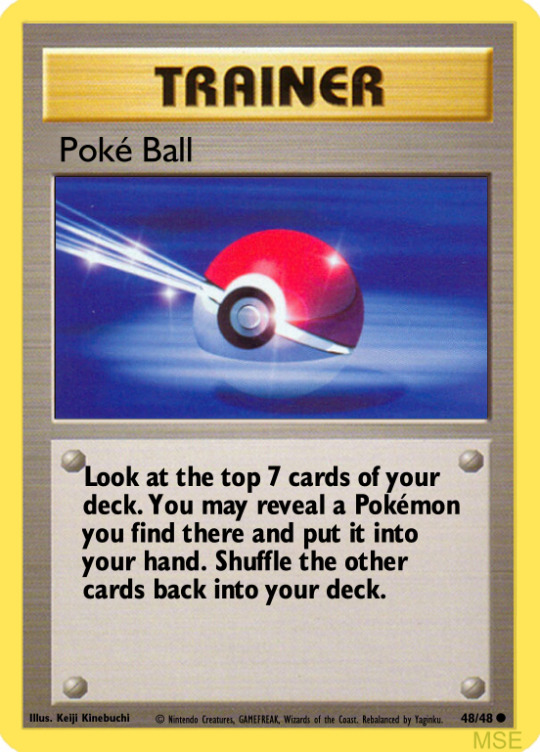
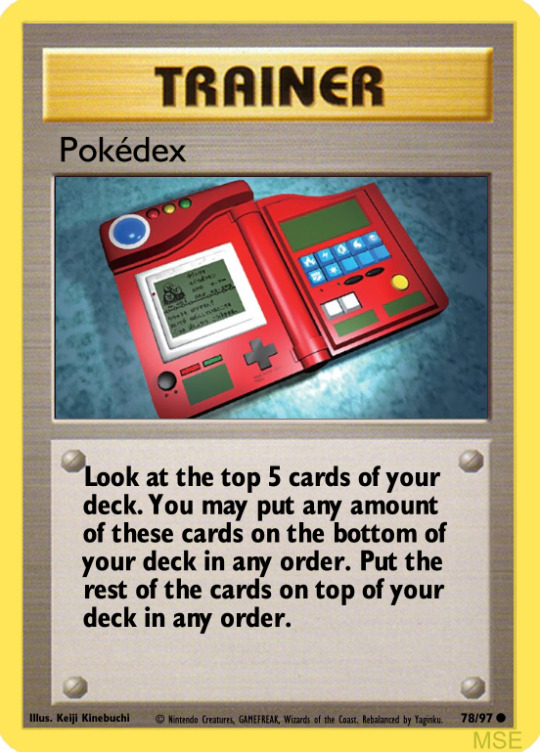
One card is missing from this whole puzzle here - Rare Candy. It's yet another card that lets you find any Pokemon from your deck without fault, but this time only working on Evolutions. For now, I want to take it slow - evolution decks deserve a strong tool to compete with basic decks and Rare Candy itself has enough conditionality that it fits the definition of what an Item Card should do.
This is a massive change for the format, because it fundamentally changes some of the best cards of the format, down to the very rules of what certain cards can and cannot do. I am excited to see what it brings.
A Char-Reminder
If there's any lesson I have taken from designing this format that's more important than any other, it's that bringing Energies back from the discard is much stronger than bringing them out of your hand. This is somewhat counter-intuitive - first of all, Energies in your hand feel much more accessible than those in your discard, since you need to put these Energies in the discard first before accessing them. Second, I already made sure there is no way to put Energies in the discard pile from your deck or hand, so you cannot sneakily accelerate using these cards. And yet, that still doesn't change the fact re-acceleration is stronger than acceleration.
The reason for that is simple, and you can see it in today's modern Pokemon TCG with decks like Gardevoir ex. Energy in your deck is a limited resource that ends, when they all find their way into your play or discard. Meanwhile, energies in your discard are unlimited - even when brought back to play, they'll find their way back through various mechanics, such as retreats and KOs. It means a recurring re-acceleration effect can bring back much more energy than a from-hand acceleration effect, even if the latter can technically put you ahead for a while. Also, since getting KO'd also means losing your energy, re-acceleration is much more important than acceleration, especially in formats that aren't ridiculously fast.
All of that is to say - Charmeleon is broken. It's a re-acceleration card with no downside. The solution, as worked out on our Discord, is to punish the use of its Power by adding one damage counter along with the energy, truly living up to its name of "Energy Burn". It still doesn't mean the card is perfectly balanced, but it'll give it some kind of downside.

Smaller Fish to Fry
I felt like Seaking was too focused on this one "blowout" attack, so I decided to pair it with a technical attack to give the card more utility, before or after the massive Waterfall.
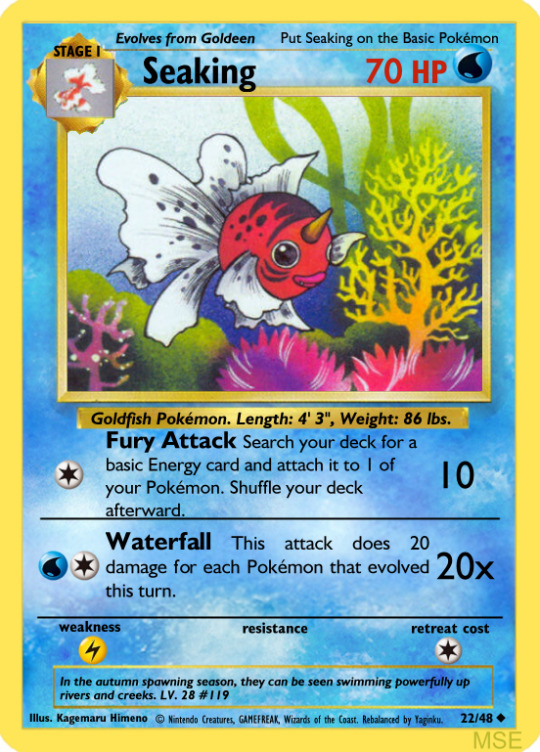
Cle-ptomaniacs
The Powers of Clefairy and Clefable have been nerfed to only works on a single Tails flip per turn. Also, Clefable's Metronome had its price increased.

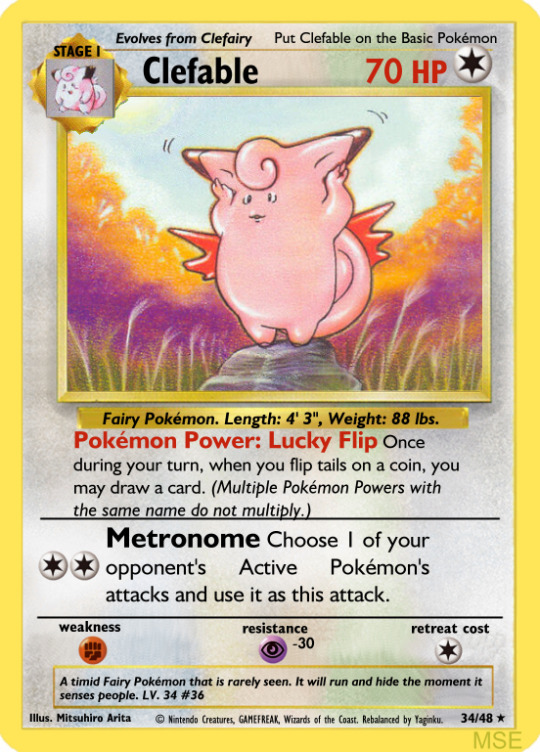
Articu-NO
This is the worst pun I came up with so far and that's your reward for getting all the way here in this massive update.
Articuno was extremely strong because of its second attack. 50 damage is nothing to scoff about, even with the restrictive cost. The added effect of stalling your opponent's entire bench was oppressive and, on top of that, it had 70 HP and no weakness. All of these needed to be torpedoed immediately. Articuno now does less damage, the amount of Paralyzed Pokemon was dropped to 2 and its health was dropped to 60.

Mewtwo
Finally, the last Pokemon that was "allowed" to discard cards. I let this Power stay specifically for Mewtwo, but I should have learned my lesson. Yes, it was abusable, because the mechanic of discarding whatever you want is abusable. The change is extremely simple and makes Mewtwo a Pokemon like any other - which is a bummer, but perhaps this concept will come back in a more balanced form.
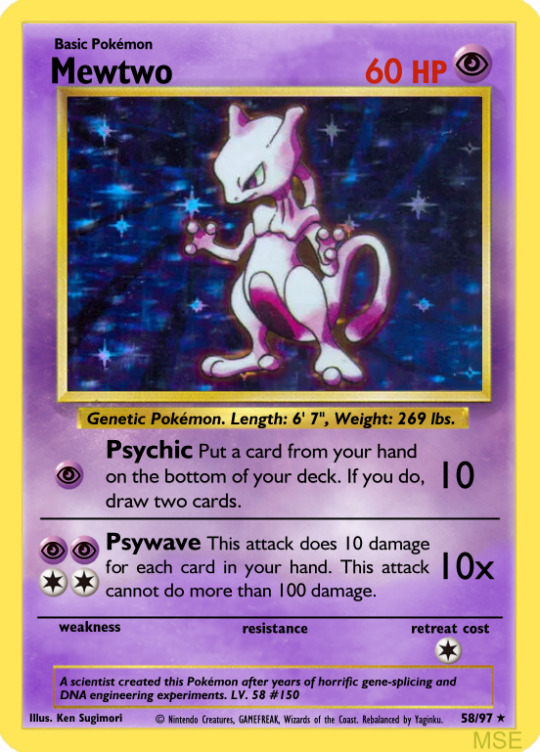
0 notes
Text
Last at the Finish Line

Slowpoke is one of the promos that never made it to the west, despite not being especially exciting. It was, however, featured in the Gameboy game. This is the first card to be included in the Base Set Remastered format that was exclusive to Japan.
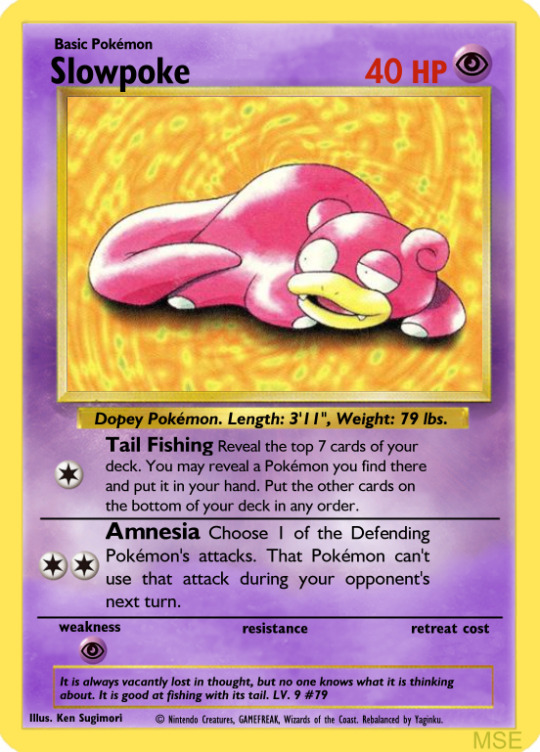
Psychic somewhat lacked good set-up basics, so I built on Slowpoke's identity by giving it a strong set-up attack. Even the Pokedex entry on this card is unique - being the translation from FireRed, which itself it an entry from the Japanese Green & Red.
0 notes
Text
From First to Last to First Again
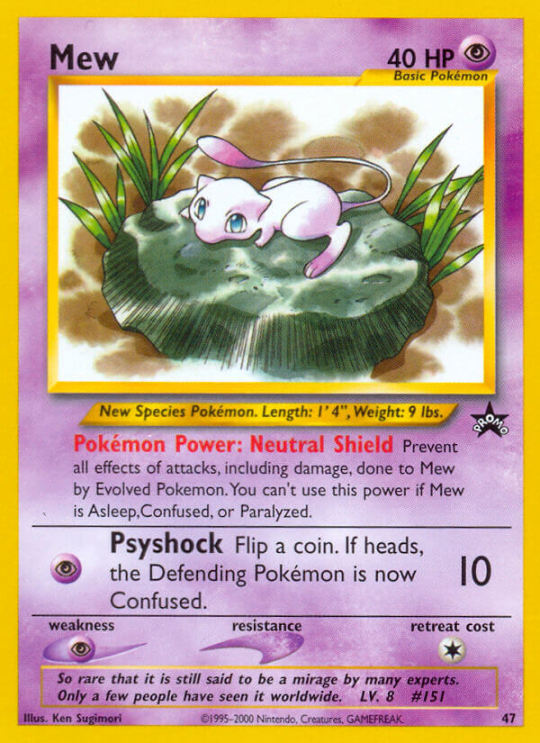
Mew is one of the first ever released promos and is featured prominently in the Gameboy game. However, the release of its English version was delayed significantly - so significantly in fact, that it landed beyond the first Generation. It was also an extremely strong card, featuring a defensive Power that blocked every attack from Evolution Pokemon. Evolution Pokemon usually require support more than hate, and the ability to completely block the entire board proves to be extremely strong in stall strategies, especially if the opponent inadvertently fills their board with Evolution Pokemon and has no way to attack Mew legitimately.
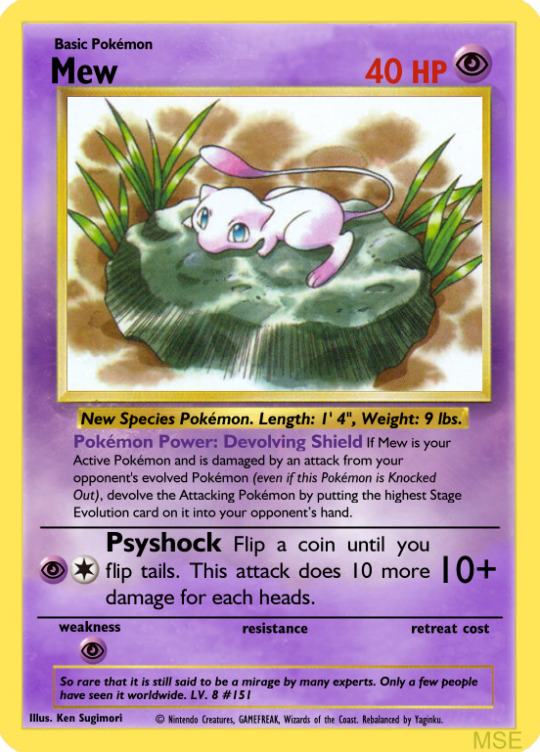
I briefly considered reworking Mew's identity of "hating evolutions" into something different, but ultimately I came up with another way of reusing the devolution effect besides a straight attack. Devolution Shield would actually work even better on a Stage 1/2 Pokemon, one that could dish serious damage while being annoying to deal with. I gave Mew as much of a "strong attack" as I could, with an infinite flip. It's a good blocker when your opponent bets on a massive Evolution Pokemon, like Charizard or Blastoise - dropping its health back to double-digits for an easier knock-out.
0 notes
Text
Last Round

The healing attack on promo Jigglypuff is somewhat concerning - healing just 10 damage isn't going to be a big deal at any point, especially when it uses your attack for the turn. That said, it's obviously a pre-evolution, so it's not meant to win games on its own.
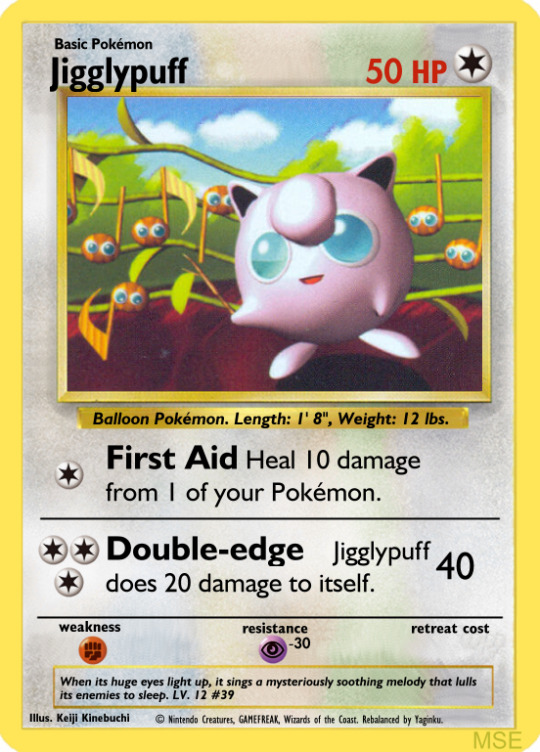
I changed the first attack a little bit to let it heal any of your Pokemon. In some marginal cases, it can be used to stall for a while. There really isn't an issue with the second attack - it's balanced quite well as it is. Removed the retreat cost as usual, and it is good to go.
1 note
·
View note
Text
But a Scratch

This seemingly boring Meowth card is actually quite interesting. It's attack is an example of a true modular attack - having two completely different effects, dependant on the result of the coin flip. Not many of these cards are printed, although it seems Meowth as a Pokemon does have an affinity for them. I do not plan to change that - just tidy things up.

First of all, I dropped the cost of the attack from 2 to 1. In essence, this attack is worse than a simple 1-for-20, like on the Base Set Rattata, because you don't have control over it. Yes, doing 20 damage on the bench is good, but your opponent gets to choose the spread, so the impact is relatively low. Some basic tidying up in the wording and removal of the retreat cost, and it's ready to go.
1 note
·
View note
Text
Lets Go To The Movies pt. 4
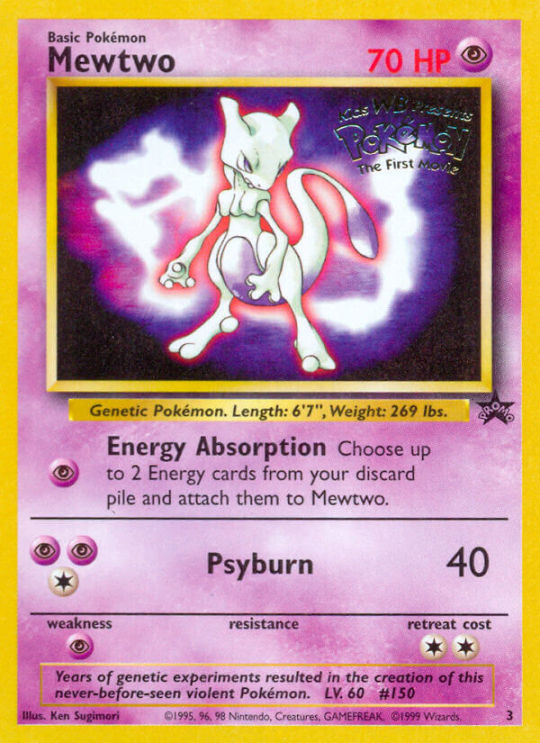
The movie is coming to a close and there's a single promo left. It's also one that'll experience the least amount of changes, because it's not that good or bad. In fact, it's somewhat of a victim of the changes this format has made a long time ago.

Because there is no way to put Energy cards in your discard pile from anywhere but the play zone, Mewtwo cannot accelerate until at least some time has passed in the game. At that point, using this ability is asking to take damage, although the reward isn't bad either. I have only docked one energy from the retreat cost, per the general rule of reducing them to more reasonable numbers.
0 notes
Text
Lets Go To The Movies pt. 3
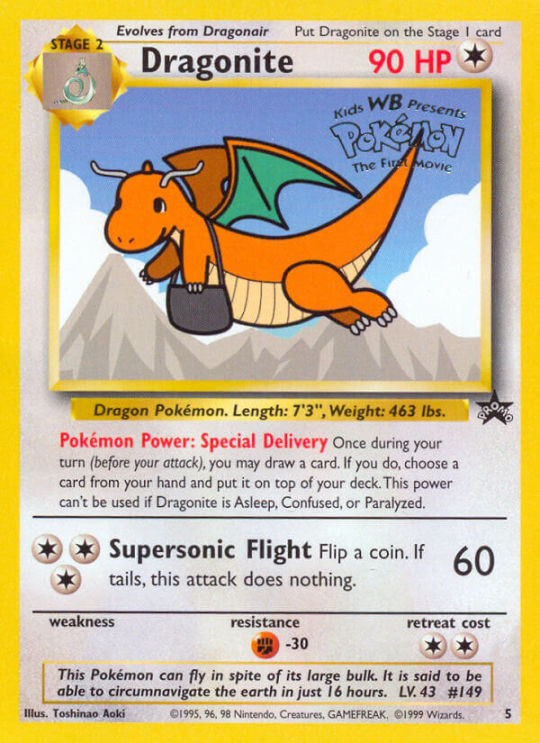
These promos are a curious case. Some are actually quite playable and perhaps even above the curve. Some, like Dragonite over here, are extremely sub-par. In general, there is a trend to make promo cards "bad on purpose" - you don't want some exclusive, hard-to-get card rocking your format. These are meant to be mainly collectible pieces, rather than actual elements of in-game strategy. However, we here are not bound by these rules, as none of these cards are "actually" released, and availability makes so difference. As such, lets get to reworking.
Dragonite's Power here is very weak. At Stage 2, you would at least expect some form of draw, not just a simple stash. Not to mention, it's another example of a passive Power on a Stage 2 Pokemon. That said, he do be carryin that bag tho. It would feel amiss to completely ignore the art and do something that doesn't relate to delivering some goods.
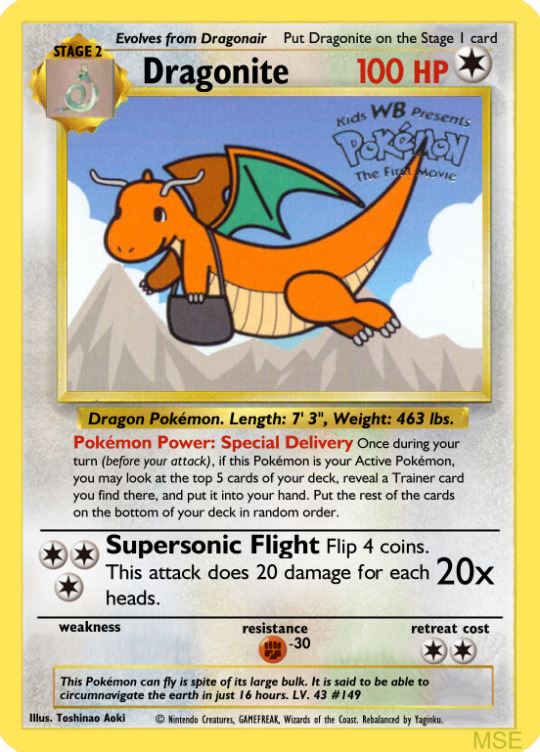
This Power is taken straight from TEU Jirachi. However, instead of being placed on a pivot Pokemon, it's instead on a massive beatstick that rather difficult to retreat. The original attack of Dragonite was massively unreliable - it still is, but to a much lesser extent. Dragonite here is a tech attacker, allowing you to fish for useful Trainer cards while dishing out some good damage.
2 notes
·
View notes
Text
Lets Go To The Movies pt. 2

I get what this attack combination was trying to do here. "Light Screen" is a type of attack that is meant to tank early-game damage, while letting you set up in peace. That's all good, but I do have to ask - Light Screen is a Psychic-type attack, let its the only Lightning-type attack on this card?
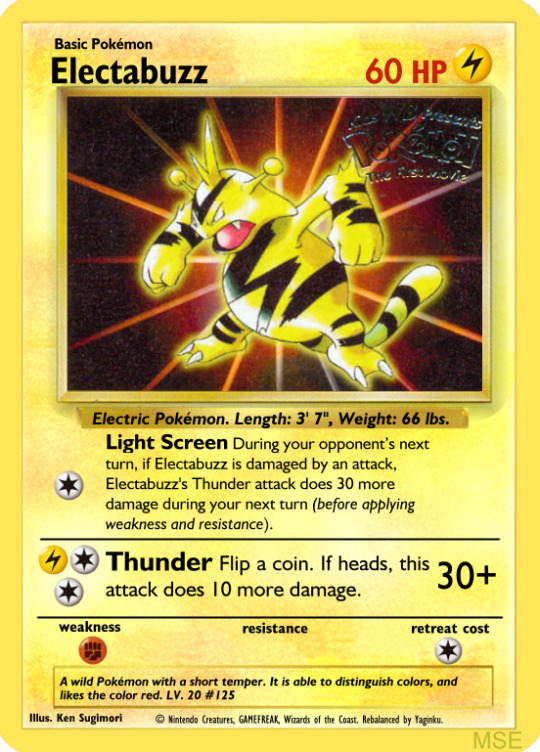
This version of Electabuzz makes it actually very similar to Jungle Scyther. Both have an damage-less attack that bumps the power of the second attack. Electabuzz can do more damage and has a stronger second attack, but is completely reliant on your opponent to trigger it, which is basically more of a deterrent, than guaranteed damage.
1 note
·
View note
Text
Lets Go To The Movies pt. 1
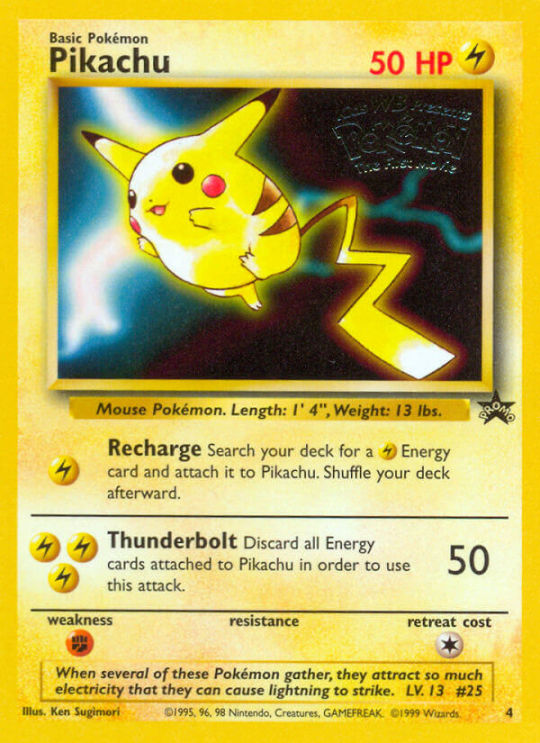
Not much to say about this Pikachu - the first attack stuck me as somewhat strong, albeit risky.
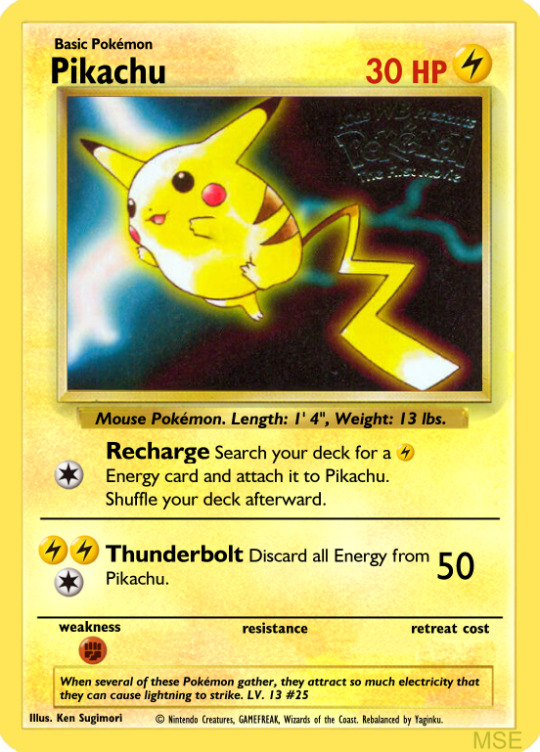
I leaned into this "risk factor" by lowering the HP quite drastically, but making Pikachu's attacks more accessible. You definitely don't want to try to Recharge in the late game, but as your first attack it might be able to sneak in a free energy, or perhaps even get a cheeky KO with a Thunderbolt.
1 note
·
View note
Text
Secret Legendary
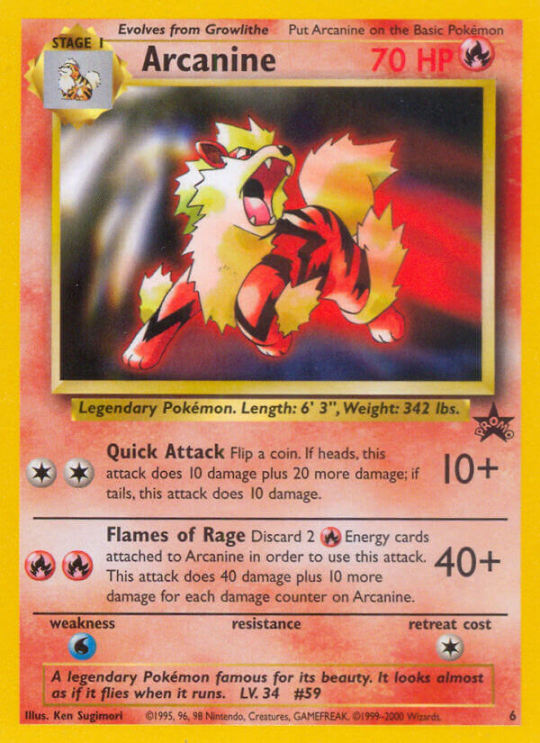
Arcanine is a pretty straightforward promo, that will get a pretty straightforward remake. Ever since I rebalanced the original Arcanine from Base Set, something felt amiss to me. Sure, the format needed this kind of "off-color" attacker as I outlined it at the time, but Arcanine is a very iconic Pokemon - a "secret fourth legendary" in some aspects, that is meant to command respect. Delegating it to a role of a support Pokemon always left a weird taste in my mouth and I am happy that, with this promo, Arcanine fans that want to put them as their main attacker can finally eat.
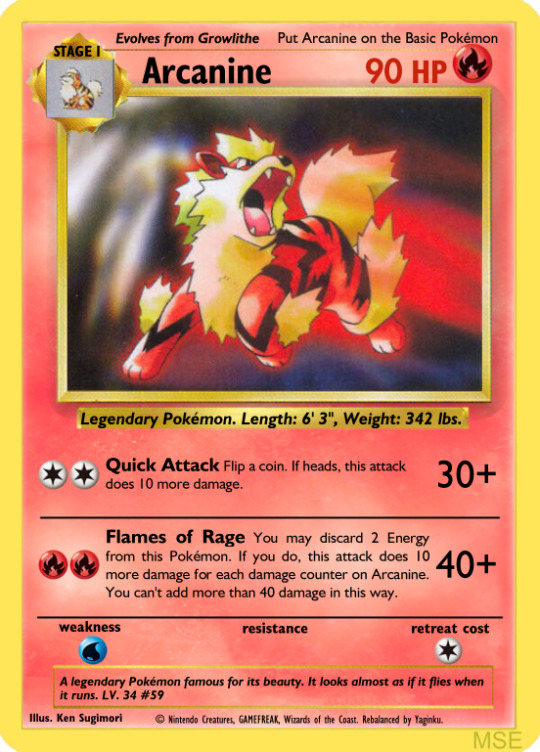
The card is very similar to the original, but with a few buffs. The major one appears in the second attack - the discard is now optional, meaning Arcanine actually has three attacks: Quick Attack, 2-for-40 and a scaling rage-type attack. This attack is extremely powerful, having the capability to hit for 80, one of the highest amounts in the format. I think that definitely commands respect.
1 note
·
View note
Text
Back to the Roots

Venusaur Promo is a card that feels relatively random. There is a couple of things to consider with cards like that. First of all, I generally have a hard time justifying changing these promos in a very drastic way. That is mostly because they exist in a sort of "vacuum" without the context of any set. This Venusaur is a great example of this, as it doesn't even have a matching Bulbasaur or Ivysaur. It just kind of exists, as an odd promo added to a few books. At the same time, I am not comfortable with giving Grass access to such strong anti-Special Condition effect - in fact, it's not a good design decision to give a Type that already is based around a Special Conditions another pillar, than being "removing Special Conditions". If your friend builds a Grass deck built around Poison and you want to tweak your deck in order to counter them, how does it feel to splash into the exact Type they're using to punish you? For some it might be acceptable, but in general it doesn't feel okay.
Another part is Venusaur's passive Pokemon Power - one of the first things I've changed in this format was removing passive Powers from Stage 2 Pokemon. In some cases having a Power on your massive Stage 2 might feel fine, but not when it's this passive. All of this gave me an idea of reworking this "passive Power" into something that would fit on a Stage 2.
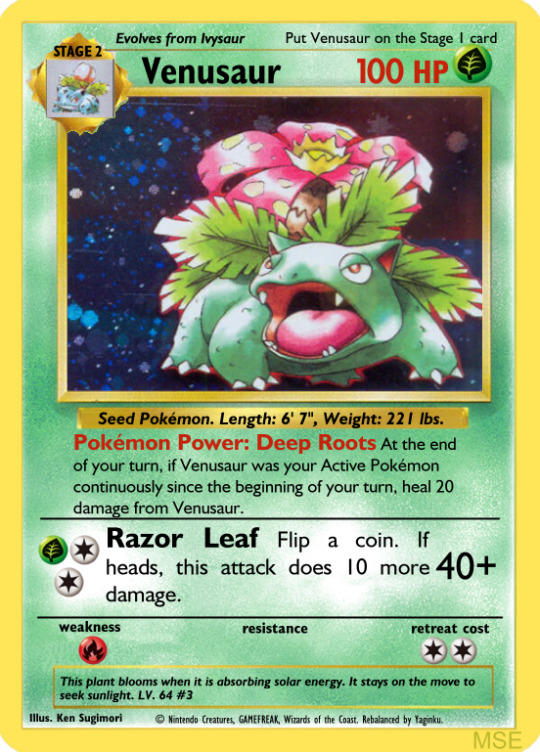
For that, I had to go back to the philosophies of each Type as I have written them. The philosophy of Grass is “Grow tall, win by attrition”. From that, I knew I wanted to make a Venusaur that rewarded the player for "sticking it" in the Active Spot and refusing to move from it. The options to do this in a concise way are limited, so I have chosen something simple and rewarding - a heal. In reality, it doesn't actually change the way the old version was played - it still swings and heals, but in a more controlled and unique manner.
1 note
·
View note